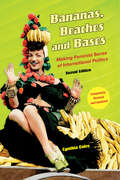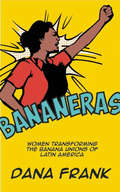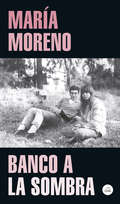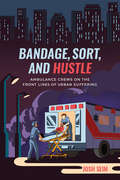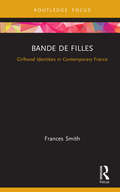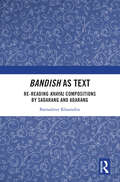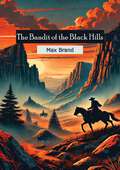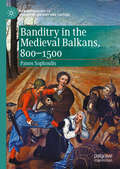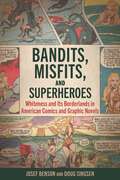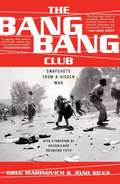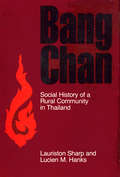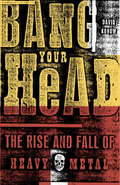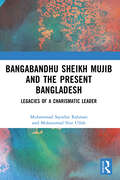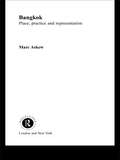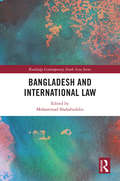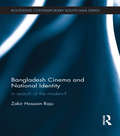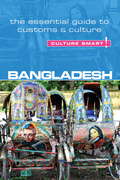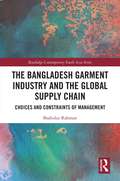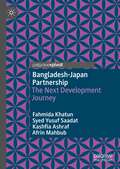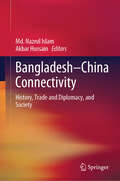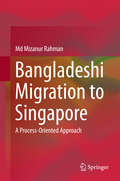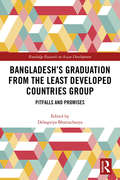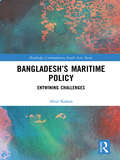- Table View
- List View
Bananas, Beaches and Bases
by Cynthia EnloeIn this brand new radical analysis of globalization, Cynthia Enloe examines recent events--Bangladeshi garment factory deaths, domestic workers in the Persian Gulf, Chinese global tourists, and the UN gender politics of guns--to reveal the crucial role of women in international politics today. With all new and updated chapters, Enloe describes how many women's seemingly personal strategies--in their marriages, in their housework, in their coping with ideals of beauty--are, in reality, the stuff of global politics. Enloe offers a feminist gender analysis of the global politics of both masculinities and femininities, dismantles an apparently overwhelming world system, and reveals that system to be much more fragile and open to change than we think.
Bananeras: Women Transforming the Banana Unions of Latin America
by Dana FrankThis story of Latina labor organizers is “a vital accounting of the struggles still being waged” (Margaret Randall, author of When I Look Into the Mirror and See You: Women, Terror, and Resistance).Women who pick and pack bananas in Latin America have organized themselves and gained increasing control over their unions, their workplaces, and their lives—while making gender equity central in their effort. Highly accessible and narrative in style, and written by the author of the award-winning Buy American: The Untold Story of Economic Nationalism, Bananeras recounts the history and growth of this vital movement and shows how Latin American woman workers are shaping and broadly reimagining the possibilities of international labor solidarity.Includes photographs.“A wonderful book—entertaining, enlightening, and inspiring. A unique blend of personal stories grounded in a solid analysis of the globalization of the banana economy, the rise of a regional banana workers movement, and the intense internal struggle for gender justice within Latin America’s historically male-dominated unions.” —Stephen Coats, former Executive Director, US Labor Education in the Americas Project
Banco a la sombra
by María MorenoUna plaza puede transformarse en el lugar donde los monumentos funerarios exhiban impresionantes erecciones, las boas abracen hasta la asfixia y las palomas ataquen en pandilla, como los compromisos políticos de la juventud o los amores si todavía habitan en los alrededores. «Somos muchos los que consideramos a María Moreno la mejor cronista argentina de todos los tiempos y una de las voces documentales más lúcidas de la lengua, entre otras hipérboles razonables.»Jorge Carrión, The New York Times «La verdad de Moreno es una norma de estilo, de un gran estilo plebeyo.»Carlos Pardo, Babelia «Hija de una época violentísima y canalla, María Moreno es una de las escritoras latinoamericanas que más me han impresionado últimamente.»Christopher Domínguez Michael «La escritura es para María Moreno la versión amorosa de lo que eran para Foucault los archivos judiciales del siglo XVIII: el lugar problemático donde "los irrescatables" -MM dixit- son interrogados y hablados, pero así y todo hacen oír, acaso por única vez, algo parecido a una voz, una voz hecha de todo lo que nadie quiere escuchar, lo que se ningunea por idiota o irrelevante, lo que se rechaza por defectuoso, balbuceante o excéntrico.»Alan Pauls
Bandage, Sort, and Hustle: Ambulance Crews on the Front Lines of Urban Suffering
by Josh SeimWhat is the role of the ambulance in the American city? The prevailing narrative provides a rather simple answer: saving and transporting the critically ill and injured. This is not an incorrect description, but it is incomplete. Drawing on field observations, medical records, and his own experience as a novice emergency medical technician, sociologist Josh Seim reimagines paramedicine as a frontline institution for governing urban suffering. Bandage, Sort, and Hustle argues that the ambulance is part of a fragmented regime that is focused more on neutralizing hardships (which are disproportionately carried by poor people and people of color) than on eradicating the root causes of agony. Whether by compressing lifeless chests on the streets or by transporting the publicly intoxicated into the hospital, ambulance crews tend to handle suffering bodies near the bottom of the polarized metropolis. Seim illustrates how this work puts crews in recurrent, and sometimes tense, contact with the emergency department nurses and police officers who share their clientele. These street-level relations, however, cannot be understood without considering the bureaucratic and capitalistic forces that control and coordinate ambulance labor from above. Beyond the ambulance, this book motivates a labor-centric model for understanding the frontline governance of down-and-out populations.
Bande de Filles: Girlhood Identities in Contemporary France (Cinema and Youth Cultures)
by Frances SmithFew films in the twenty-first century have represented coming-of-age with the beauty and brutality of Bande de Filles (or Girlhood). This book provides an in-depth examination of Céline Sciamma’s film, focusing on its portrayal of female adolescence in contemporary Paris. Motivated by the absence of black female characters in French cinema, Sciamma represents the lives of figures that have passed largely unnoticed on the big screen. While observing the girls’ tough circumstances, Sciamma’s film emphasises the joy and camaraderie found in female friendships. This book places Girlhood in its cinematic as well as its sociocultural context. Pop music, urban violence, and female friendships are all considered here in a book that draws out the complexity of Sciamma’s deceptively simple portrayal of coming-of-age. Thoughtful, concise, and deeply contemporary, this book is perfect for students, scholars, and general readers interested in youth cultures, European cinema, gender, and sexuality.
Banding Together: How Communities Create Genres in Popular Music
by Jennifer C. LenaWhy do some music styles gain mass popularity while others thrive in small niches? Banding Together explores this question and reveals the attributes that together explain the growth of twentieth-century American popular music. Drawing on a vast array of examples from sixty musical styles--ranging from rap and bluegrass to death metal and South Texas polka, and including several created outside the United States--Jennifer Lena uncovers the shared grammar that allows us to understand the cultural language and evolution of popular music. What are the common economic, organizational, ideological, and aesthetic traits among contemporary genres? Do genres follow patterns in their development? Lena discovers four dominant forms--Avant-garde, Scene-based, Industry-based, and Traditionalist--and two dominant trajectories that describe how American pop music genres develop. Outside the United States there exists a fifth form: the Government-purposed genre, which she examines in the music of China, Serbia, Nigeria, and Chile. Offering a rare analysis of how music communities operate, she looks at the shared obstacles and opportunities creative people face and reveals the ways in which people collaborate around ideas, artworks, individuals, and organizations that support their work.
Bandish as Text: Re-reading Khayal Compositions by ‘Sadarang’ and ‘Adarang’
by Barnashree KhasnobisThis book provides a socio-cultural analysis of khayal bandishes composed by Ne’mat Khan ‘Sadarang’ and Feroze Khan ‘Adarang’. It argues that deciphering khayal bandishes as cultural symbols provides an understanding of the constitution of medieval Indian society and shows how society gets represented via such symbols. The author examines the cultural forces that nurtured the context of compositions by Sadarang and Adarang. She touches upon the cultural exchanges between Hindu and Muslim communities through scholarly and philosophical discourses to create a rationale for khayal as a syncretic form of art.A unique contribution to the study of Indian culture and music, the book will be an indispensable resource for students, teachers, and researcher scholars of South Asian studies, Hindustani music, cultural studies, history, and medieval Indian society.
The Bandit of the Black Hills
by Max BrandMax Brand’s The Bandit of the Black Hills is a thrilling Western adventure filled with danger, intrigue, and the enduring fight for justice. Set against the rugged and wild backdrop of the Black Hills, this classic tale captures the essence of the frontier, where law and order are fragile and courage is the ultimate currency.The story follows a mysterious outlaw whose reputation as a bandit strikes fear into the hearts of settlers and lawmen alike. But as whispers of his exploits spread, it becomes clear that there’s more to this enigmatic figure than meets the eye. When a determined young hero crosses paths with the infamous bandit, their fates become intertwined in a high-stakes battle against corruption, greed, and betrayal.Brand’s masterful storytelling brings the Black Hills to life, with vivid landscapes and dynamic characters that leap off the page. As the plot unfolds, readers are drawn into a world of secret identities, daring escapes, and unexpected alliances. The novel’s fast-paced action and moments of heartfelt emotion make it a standout in the Western genre.The Bandit of the Black Hills is a testament to Max Brand’s legendary skill as a writer, blending compelling narrative with themes of redemption, loyalty, and the pursuit of justice. Perfect for fans of classic Westerns and timeless tales of heroism, this novel delivers an unforgettable journey into the heart of the American frontier.
Banditry in the Medieval Balkans, 800-1500 (New Approaches to Byzantine History and Culture)
by Panos SophoulisThis book explores the history of banditry in the medieval Balkans between the ninth and fifteenth centuries. While several scholars have recognized the problems which various outlaw groups caused in the region during the Middle Ages, few have given much attention to the bandits themselves, their origins, their reasons for taking up brigandage, and the steps taken by the central authorities to control their activity. Among other things, this book identifies three main sources of banditry: shepherds, soldiers and peasants. Far from being ʻlone wolvesʼ, these men operated within well-defined social networks. Poverty played a decisive role in driving them to a life of crime, but there is strong evidence to suggest that the growing economic prosperity in parts of the Balkans from the ninth century onwards may have also contributed to the rise of the phenomenon.
Bandits, Misfits, and Superheroes: Whiteness and Its Borderlands in American Comics and Graphic Novels
by Josef Benson William SingsenShortlisted Finalist for the 2023 Eisner Award for Best Academic/Scholarly WorkAmerican comics from the start have reflected the white supremacist culture out of which they arose. Superheroes and comic books in general are products of whiteness, and both signal and hide its presence. Even when comics creators and publishers sought to advance an antiracist agenda, their attempts were often undermined by a lack of awareness of their own whiteness and the ideological baggage that goes along with it. Even the most celebrated figures of the industry, such as Jerry Siegel and Joe Shuster, Jack Jackson, William Gaines, Stan Lee, Robert Crumb, Will Eisner, and Frank Miller, have not been able to distance themselves from the problematic racism embedded in their narratives despite their intentions or explanations.Bandits, Misfits, and Superheroes: Whiteness and Its Borderlands in American Comics and Graphic Novels provides a sober assessment of these creators and their role in perpetuating racism throughout the history of comics. Josef Benson and Doug Singsen identify how whiteness has been defined, transformed, and occasionally undermined over the course of eighty years in comics and in many genres, including westerns, horror, crime, funny animal, underground comix, autobiography, literary fiction, and historical fiction. This exciting and groundbreaking book assesses industry giants, highlights some of the most important episodes in American comic book history, and demonstrates how they relate to one another and form a larger pattern, in unexpected and surprising ways.
The Bang-Bang Club: Snapshots From a Hidden War
by Greg Marinovich João SilvaDuring the final, bloody days of South African apartheid, four remarkable young men-photographers, friends, and rivals-banded together
Bang Bang, Shoot Shoot! Essays on Guns and Popular Culture (Second Edition)
by Murray Pomerance John SakerisThe essays in this book all relate to movies or television in which guns played a significant role. The director's use of guns is explored and the statement he is trying to make is often analyzed.
Bang Chan: Social History of a Rural Community in Thailand (Cornell Studies in Anthropology)
by Lauriston Sharp Lucien M. HanksBang Chan traces the changing cultural characteristics of a small Siamese village during the century and a quarter from its founding as a wilderness settlement outside Bangkok to its absorption into the urban spread of the Thai capital. Rich in ethnographic detail, the book sums up the major findings of a pioneering interdisciplinary research project that began in 1948. Changes in Bang Chan's social organization, technology, economy, governance, education, and religion are portrayed in the context of local and national developments.
Bang Your Head: The Rise and Fall of Heavy Metal
by David KonowLike an episode of VH1's Behind the Music on steroids, BANG YOUR HEAD is an epic history of every band and every performer that has proudly worn the Heavy Metal badge. Whether headbanging is your guilty pleasure or you firmly believe that this much-maligned genre has never received the respect it deserves, BANG YOUR HEAD is a must-read that pays homage to a music that's impossible to ignore, especially when being blasted through a sixteen-inch woofer. Charting the genesis of early metal with bands like Black Sabbath and Iron Maiden; the rise of metal to the top of the Billboard charts and heavy MTV rotation featuring the likes of Def Leppard and Metallica; hitting its critical peak with bands like Guns N' Roses; disgrace during the "hair metal" '80s; and a demise fueled by the explosion of the Seattle grunge scene and the "alternative" revolution, BANG YOUR HEAD is as funny as it is informative and proves once and for all that there is more to metal than sin, sex, and spandex. To write this exhaustive history, David Konow spent three years interviewing the bands, wives, girlfriends, ex-wives, groupies, managers, record company execs, and anyone who was or is a part of the metal scene, including many of the band guys often better known for their escapades and bad behavior than for their musicianship. Nothing is left unsaid in this jaw-dropping, funny, and entertaining chronicle of power ballads, outrageous outfits, big hair, bigger egos, and testosterone-drenched debauchery.
Bangabandhu Sheikh Mujib and the Present Bangladesh: Legacies of a Charismatic Leader
by Muhammad Sayadur Rahman Mohammad Nur UllahSheikh Mujibur Rahman, known as Bangabandhu by his followers/countrymen, is the most prominent political figure in the emergence of Bangladesh. Bangabandhu transcended his contemporaries and even his political mentors considering the impact he had on the creation of the new nation-state. This book presents a comprehensive overview of the leadership and legacy of Bangabandhu Sheikh Mujib in the framing of modern Bangladesh. It discusses themes like the formation of Bangladesh; the Bengali nationalist movement; Bangabandhu and his political socialization; Bangabandhu’s political and administrative philosophy and his economic and developmental thoughts. Topical and lucid, this book is a must-read for scholars and researchers of Political Science, South Asian Politics, South Asian History, Political Leadership, Political Sociology and also for the Bangladeshi diaspora.
Bangkok: Place, Practice and Representation (Asia's Transformations/Asia's Great Cities)
by Marc AskewBangkok is one of Asia's most interesting, varied, controversial and challenging cities. It is a city of contradictions, both in its present and past. This unique book examines the development of the city from its earliest days as the seat of the Thai monarchy to its current position as an infamous contemporary metropolis. Adopting insights from anthropology, urban studies and human geography, this is a powerful account of the city and its dynamic spaces. Marc Askew examines the city's variety from the inner-city slums to the rural-urban fringe, and gives us a keen insight into the daily life of the city's inhabitants, be they middle-class suburbanites or sex workers.
Bangladesh and International Law (Routledge Contemporary South Asia Series)
by Mohammad ShahabuddinThis book is the first-ever comprehensive analysis of international law from Global South perspectives with specific reference to Bangladesh. The book not only sheds new light on classical international law concepts, such as statehood, citizenship, and self-determination, but also covers more current issues including Rohingya refugees, climate change, sustainable development, readymade garment workers and crimes against humanity. Written by area specialists, the book explores how international law shaped Bangladesh state practice over the last five decades; how Bangladesh in turn contributed to the development of international law; and the manner in which international law is also used as a hegemonic tool for marginalising less powerful countries like Bangladesh. By analysing stories of an ambivalent relationship between international law and post-colonial states, the book exposes the duality of international law as both a problem-solving tool and as a language of hegemony. Despite its focus on Bangladesh, the book deals with the more general problem of post-colonial states’ problematic relationship with international law and so will be of interest to students and scholars of international law in general, as well as those interested in the Global South and South Asia in particular.
Bangladesh Cinema and National Identity: In Search of the Modern? (Routledge Contemporary South Asia Series)
by Zakir Hossain RajuThroughout the twentieth and early twenty-first centuries, cinema has been adopted as a popular cultural institution in Bangladesh. At the same time, this has been the period for the articulation of modern nationhood and cultural identity of Bengali Muslims in Bangladesh. This book analyses the relationship between cinema and modernity in Bangladesh, providing a narrative of the uneven process that produced the idea of "Bangladesh cinema." This book investigates the roles of a non-Western "national" film industry in Asia in constructing nationhood and identity within colonial and postcolonial predicaments. Drawing on the idea of cinema as public sphere and the postcolonial notion of formation of the "Bangladesh" nation, interactions between cinema and middle-class Bengali Muslims in different social and political matrices are analyzed. The author explores how the conflict among different social groups turned Bangladesh cinema into a site of contesting identities. In particular, he illustrates the connections between film production and reception in Bangladesh and a variety of nationalist constructions of Bengali Muslim identity. Questioning and debunking the usual notions of "Bangladesh" and "cinema," this book positions the cinema of Bangladesh within a transnational frame. Starting with how to locate the "beginning" of the second Bengali language cinema in colonial Bengal, the author completes the investigation by identifying a global Bangladeshi cinema in the early twenty-first century. The first major academic study on this large and vibrant national cinema, this book demonstrates that Bangladesh cinema worked as different "public spheres" for different "publics" throughout the twentieth century and beyond. Filling a niche in Global Film and Media Studies and South Asian Studies, it will be of interest to scholars and students of these disciplines.
Bangladesh - Culture Smart!
by Urmi RahmanBangladesh is a lush, green country situated on the fertile Ganges delta, adjacent to the Indian state of West Bengal. Although there are hilly areas in the northeast, this densely populated country is mostly flat, and criss-crossed by many rivers. Much of its coastline forms part of the world's largest mangrove forests, the Sundarbans, home to the Royal Bengal tiger and many other flora and fauna. Bangladesh is young country with an ancient history. The province of Bengal was divided when India became independent in 1947, and its mainly Muslim eastern part became East Pakistan. This was followed by years of upheaval, and in 1971, after a freedom movement and a war, the east Bengali people finally gained independence as the People's Republic of Bangladesh. Most Bangladeshis live in rural areas, and the majority are Muslims. Historically they have lived in harmony with many other faiths. Bengali, or Bangla, is the lingua franca, and there are several regional dialects. Once the hub of the southern Silk Route, the Bengal delta region has a long and rich cultural tradition. Over the centuries it has been influenced by Hinduism, Jainism, Buddhism, Islam, and Christianity. It is a land of writers, saints, scientists, thinkers, composers, painters, and film-makers. It is famous for its music, dance, and drama; arts and crafts; folklore; languages and literature; philosophy and religion; festivals and celebrations; and its distinctive cuisine and culinary tradition. Bangladesh has been regularly hit by floods and cyclones, but, contrary to what the world usually hears about natural disasters and poverty, there is positive economic growth and the country is one of southeast Asia's largest exporters of garments to Western markets. Despite the hardships they endure the Bangladeshis are resilient, friendly, and hospitable, and welcome all visitors with a warm smile. This book introduces you to the people beyond the headlines, and offers invaluable advice on what to expect and how to behave in different situations, whether you are a tourist or traveling on business.
The Bangladesh Garment Industry and the Global Supply Chain: Choices and Constraints of Management (Routledge Contemporary South Asia Series)
by Shahidur RahmanThis book analyzes the choices and constraints of management within the Bangladesh garment industry and how management negotiates these challenges to ensure the global garment supply chain is sustainable. Exploring the international South Asian garment industry and using middle management and the owners of Bangladeshi factories as a case study, the book assesses the limits and costs of globalization for Bangladesh, and outlines the challenges of the fast-fashion business model for the global market. It focusses on the changing dynamics of the entrepreneur class, how they manage factories and their experiences with Accord-Alliance, and the challenges of sustainability. Within these four broader themes, the author critically examines management strategies towards compliance and labour productivity, transnational governance, buyer–supplier relationships, and power dynamics. This book is the first to explore management’s perceptions of workers, buyers, and government through an analysis of four factories which demonstrate the role of mid-level management, how supervisors treat production workers, workers’ impact on innovation, welfare programmes as well as CSR policies, and the impact of COVID-19. Offering new perspectives on Bangladesh’s garment export industry, this book will be of interest to researchers in the field of policy studies, labour studies, South and South-East Asian studies, development studies, international trade, and political science.
Bangladesh-Japan Partnership: The Next Development Journey
by Fahmida Khatun Syed Yusuf Saadat Kashfia Ashraf Afrin MahbubThis book analyses the trade relationship between Bangladesh and Japan, including foreign investments and foreign aid by Japan to Bangladesh. It emphasises how Japan may support Bangladesh in its next development journey during the fourth industrial revolution (4IR) and after Bangladesh’s Least Developed Country (LDC) graduation. This is the first book to present a comprehensive evaluation of Bangladesh's economic relationship with Japan, including how it has evolved over the preceding fifty years and its possibilities and implications for the future.The book draws attention to the importance of increased economic diversification for Bangladesh in terms of skill and productivity with the increasing need to accelerate technological adoption from Japan to be on par with international competition following Bangladesh’s LDC graduation. It presents a thorough examination of Bangladesh's prospects to access the Japanese market, as well as Japan's assistance in the development of human capital and infrastructure in Bangladesh. It also discusses how Bangladesh might both attract additional foreign direct investment (FDI) from Japan and improve its technical skills by utilising expertise obtained through Japanese investments.This new study will inform policy discourse, influence relevant policies, and inspire future research on these key issues.
Bangladesh–China Connectivity: History, Trade and Diplomacy, and Society
by Md. Nazrul Islam Akbar HussainThis book adopts an interdisciplinary social science approach. It includes original research papers on Bangladesh-China’s connectivity to archaeology, history, religion, traditional Chinese medicine, language and literature, women and gender, diplomacy and strategic relations, bilateral business and trade, and the Belt and Road Initiative (BRI). Most of the existing literature perceives bilateral and regional connectivity from economic and strategic points of view and emphasizes financial and political profit-loss and integration. This book combines the archeological and cultural issues from history and diplomacy, and soft power from the present. The content of this book has a broader scope and is divided into six parts including background and introduction; archeology, history, and religion; business and trade; diplomacy and geo-strategy; traditional Chinese medicine; language and literature; and society, culture, and gender. This book is particularly designed for undergraduate and postgraduate students, researchers, academics, journalists, and strategic think tanks from broader humanities and social sciences backgrounds including, history, archeology, religious studies, philosophy, sociology, anthropology, political sciences, international relations, economics, environmental studies, language and literary studies, gender studies, health studies, and business.
Bangladeshi Migration to Singapore
by Md Mizanur RahmanThis book examines international labour migrants in the context of South–South migration with a focus on Bangladeshi migration to Singapore. Two principal questions in the South–South migration are addressed: Why and how individuals migrate for work; and what impact this temporary form of migration has for migrants and their families. The book adopts a relatively new methodological approach to labour migration by linking different phases that migrants undergo in the migration process and by combining migrants in the host country with their families in the origin country. This is achieved through identifying and addressing six key areas: (i) migration policy, (ii) social imperatives of migration (iii) recruitment, (iv) social worlds of the migrants, (v) remittance process, and finally, (vi) family development dynamics. This book introduces the bari to migration research as a unit of analysis over and above individual and family units. The book reveals how social and cultural forces both initiate and perpetuate migration, and later on influence bari dynamics.
Bangladesh's Graduation from the Least Developed Countries Group: Pitfalls and Promises (Routledge Research on Asian Development)
by Debapriya BhattacharyaSince the group of least developed countries (LDCs) was identified in 1971, only five countries have graduated from the group, all of which are characterised by small size or population. The projections are that the next decade will see a rapid increase in the pace of graduation, with Bangladesh in particular poised to be one of the largest countries, in terms of its economy and population, yet to leave the group. While previously many LDCs viewed the prospect of graduation with some apprehension, fearing significant erosion of international support, increasingly, the move is being seen as a more positive landmark. This book aims to articulate appropriate strategies and initiatives to help Bangladesh to maintain its developmental momentum and to prepare for a sustainable graduation in 2024. In doing so, the book explores themes such as key analytical issues of the LDC graduation paradigm, smooth transition and structural transformation, and post-graduation challenges and opportunities. Further, against the backdrop of Gross National Income per capita, the Human Assets Index and Economic Vulnerability Index goals required for graduation, the Sustainable Development Goals (SDGs) set by the 2030 Agenda will also be in the process of implementation. Whilst some feel that the two agendas might be in conflict, the book teases out some of the important synergies which can be drawn when LDCs are undertaking the journey of graduation in the era of the SDGs. The book also takes into cognisance the uncertain external environment and the emerging global scenario within which Bangladesh's graduation is to take place. Conceptual discourse around LDC graduation and the particular narrative around Bangladesh's journey towards LDC graduation will be of interest not only to scholars of Bangladesh, but also to researchers and policymakers with an interest in LDC graduation for other countries facing similar challenges.
Bangladesh’s Maritime Policy: Entwining Challenges (Routledge Contemporary South Asia Series)
by Abul KalamFollowing successive international legal verdicts, Bangladesh is now an accredited maritime state. Possessing a spacious territorial sea and an extended continental shelf, with a maritime zone almost equalling its land borders, a ‘window of opportunity’ has opened for the country to realise its developmental aspirations. Yet, it faces numerous challenges, many of which are entwined. This book is a detailed analysis of Bangladesh’s maritime strategy. It charts the country’s maritime legacies, including disputes with both Myanmar and India and analyses the contributions of the leadership in the maritime territorial gains. <P><P>The author examines Bangladesh’s need to consolidate these newly reclaimed gains, whilst exploring the unremitting interest of major global power players in maintaining maritime resource exploitation, navigation and security. Finally, the author demonstrates how the country needs to embrace the notional principles of sustainable development of its ocean economy to utilize its resources and how it has since been coming to grips with the emerging concept of "blue economy" to enhance its enduring national development. <P><P>The first systematic study on Bangladesh’s maritime policy and the country’s importance in the emerging geopolitical rivalry in the Indian Ocean, this book will be of interest to academics in the field of South Asian and Indian Ocean politics.
